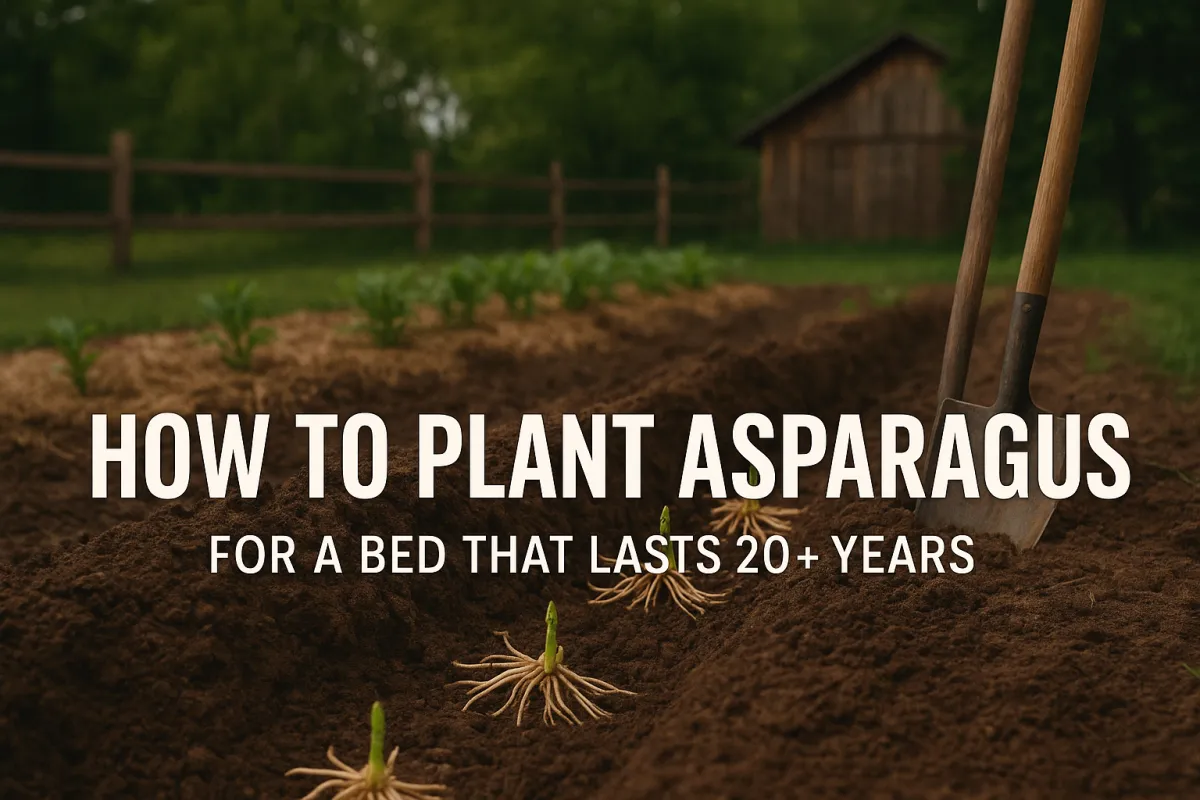
How to Plant Asparagus for a Bed That Lasts 20+ Years
Why Asparagus Is a Legacy Crop
The first time I planted asparagus, I remember standing in the garden with a bundle of crowns and realizing: this isn’t a one-season decision. If I got it right, those little roots would outlast cars, tools, even some friendships—feeding us for two decades or more. That thought alone changed how I looked at the job.
Unlike quick crops you can reseed if they fail, asparagus asks you to think long-term. Once it’s in, it’s in. That’s why so many beginners get frustrated—they put it in a poor spot, rush the first harvest, or let weeds choke it out. Get the foundation right, though, and you’ll eat like a king for the next 20+ years.
Choosing the Right Spot (Site Selection)
Asparagus is unforgiving when it comes to where you plant it. Think carefully before you dig.
Full Sun and Drainage
This crop wants sunlight all day. Give it shade, and you’ll get spindly spears instead of the thick, satisfying stalks you’re after. Drainage matters just as much—crowns rot fast if they sit in soggy soil.
Deep, Fertile Soil Preparation
Before you even think about laying down crowns, work the ground at least 12–18 inches deep. A shovel and a strong back will do the job, but if you’ve got a tiller, now’s the time to use it. Blend in compost and aged manure—this is a bed you won’t be able to “reset” later.
Region-specific note: In colder USDA Zones (4–6), asparagus thrives thanks to the winter chill that resets the crowns. In hot southern climates (Zones 8–9), choose heat-tolerant varieties and prioritize drainage.
Grandma’s Tip: “Pick your asparagus spot like you’d pick a place to build your house—you won’t be moving it later.”
Digging Trenches the Right Way
This is where most folks cut corners. Don’t.
Dig trenches 8–12 inches deep.
Make them about a foot wide.
Orient them straight—rows are easier to weed and mulch if they’re lined up clean.
Before planting, sprinkle in compost and loosen the bottom of the trench with a garden fork. Think of it like bedding a cradle—you’re setting up the crowns for comfort.
Planting Crowns and Backfilling Gradually
Asparagus crowns look like a bundle of octopus legs. Spread them out so every root has room to run.
Spacing: Place crowns 12–18 inches apart in the row, with 3 feet between rows.
Planting: Set each crown on a little mound of soil at the trench bottom, roots draping down. Cover with just 2–3 inches of soil at first.
Backfilling: As the shoots grow, keep adding soil until the trench is filled. This encourages deep, strong roots.
📥 Printable Tool: Download my Asparagus Planting Calendar & Spacing Guide for a simple, step-by-step reminder you can hang in the shed.
Mulching and Watering for Strong Establishment
Once the crowns are covered, protect your investment.
Mulch the rows with straw or shredded leaves to hold moisture and block weeds.
Water consistently the first season. Asparagus hates to dry out during establishment.
Avoid waterlogging—if your soil stays too wet, crown rot sets in fast.
Pro Tip (Avoid This Mistake): Never use fresh manure after planting. It burns young crowns and introduces weeds that will haunt your bed for years.
The First Three Years: Patience Pays Off
This is where discipline separates good growers from the rest.
Year 1: Don’t harvest a single spear. Let every shoot grow tall into ferns. These ferny stalks feed the roots for the decades ahead.
Year 2: Take just a taste—maybe a handful of spears for the table. Leave the rest to strengthen the crowns.
Year 3: Begin light, careful harvesting for 2–3 weeks. By the end of this season, you can extend to a full harvest window of 6–8 weeks each year.
After every harvest, fertilize with compost or a balanced organic blend to recharge the roots.
Faith Tie-in: The Long Game
Asparagus is a crop of patience. You invest years before you see full returns. It’s not unlike the Christian walk—obedience today often yields fruit much later.
“And let us not grow weary while doing good, for in due season we shall reap if we do not lose heart.” — Galatians 6:9
The discipline of waiting—of trusting unseen work beneath the soil—is part of the gift.
Closing: Building a Bed for Generations
When you dig trenches this spring, you’re not just planting for yourself. You’re setting up a harvest your kids and grandkids may still enjoy. That’s legacy food—steady, faithful, dependable.
Take it one step at a time: pick the site, dig the trenches, plant the crowns. By this weekend, you could have the start of a bed that will feed your family for the next 20 years.


Facebook
Instagram
X
Youtube